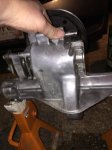if you do not get an answer in a couple of days, click on the [more] link on the right side then from the window that pops up select the :anyone: emojie.
This will bump your thread back into the "New posts " list so when regular posters go on line it will pop up.
I ( and I suspect many others ) do not get emails from the forum, I get around 200 or so a day so another 40 is not on.
Thus when people stop posting , the thread goes dead.
From where it was it looks like the suggestion of a jumping dog will be correct so it is time to pull out the tranny,
Usually a dog not properly engaging can be heard from 50' away with its distinctive machine gun ( jackhammer if you like ) rattle cause by the dogs grating over each other.
In the original post you did not mention this which is why those who repair mowers for a lining were concentrating on belts, pulleys & springs as these are fairly well quiet when they slip.
Just one of those things that happen when you are trying to diagnose from text on a screen
So it will be out with the tranny.
A fairly simple job as you already are an expert in changing the belts, after that it is just a matter of dissengaging the FNR control rod and the brake rod.
Double check the parts diagram as there are the 4 bolts on the axel itself ( 2 either side ) plus some stabilizers that are easy to overlook.
Give the tranny a really good clean as you do not want grit to get in there as then you have to change all of the grease and that is really messy.
On some the big pulley can be left in place on others it overhangs the case bolts so it has to come off.
DO not pull the shaft out or you will have to replace the seals and this goes for the axels as well.
there are some pry points to lever the two sides apart and then lift the top off.
Usually you only need to replace the actual sliding dog.
The shaft that moves it has some indents that run over a spring loaded ball bearing to index the sliding dog.
It has a habbit of vanishing into space when you take the dog out.
I used to clean all of the old dry grease out but now I just add some fresh 00 grease to free things up a bit.
A bit clumsy to explain but once apart it will be very obvious how it works.
Apart from the actual sliding dog, the collar that shifts it wears and so does the bushes at either end which allow the entire shaft to move left right.
They are not expensive and usually I replace the dog gear and both bushes,
Some have facilities for shims to go under the bushes to take up the free play.
OK, I finally had a good weekend to start looking at this thing. I will post some pics at the bottom, but they are just of the trans after I took it out, and some are before I cleaned it up. Pressure washer, then a scrub brush and some dawn, then n the tight areas some brake cleaner.
My trans pulley sits over 5 bolts, but unless they are extremely long, I should be able to get them out. You mention the "dog" not engaging. Are you referring to the shaft that slides over the ball bearing, or the peace that engages the fwd/rev gears? I did find a youtube video and this is the problem they had, but he couldn't engage drive at all according to him.
I have an early movie date with the wife and kids tomorrow, but will be home around lunch to crack this thing open.
Thanks for your assessment on my situation, as to all the others that that had replied previously.












